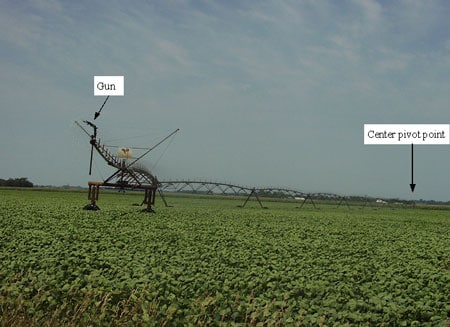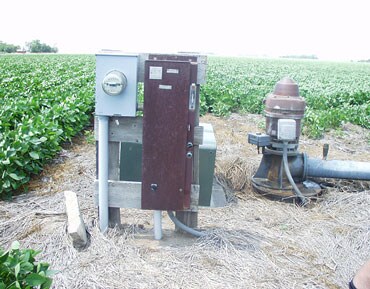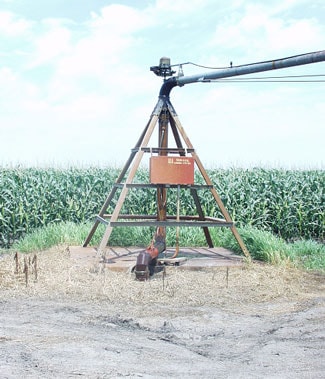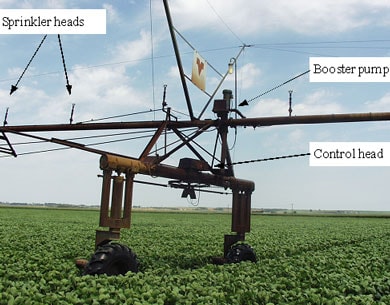Irrigation System Serviceman Electrocuted
December 30, 2003
Nebraska FACE Investigation 03NE027
SUMMARY:
A 55-year-old irrigation systems repairman was killed when he made contact with live wires while working on a booster pump in a center-point pivot irrigation system. The victim was standing above ground level on the system’s metal bracing when he made contact with energized wires. A co-worker and a passing motorist saw sparks from the victim’s location. As the victim fell from the structure his foot became tangled in the framework. The co-worker and motorist were able to remove the victim. Local emergency personnel were summoned. They transported the victim to a local hospital where he was pronounced dead.
The Nebraska Workforce Development, Department of Labor’s Investigator concluded that to help prevent future similar occurrences:
- employers should develop a written Safety & Health program that is “company specific”.
- employers should develop a Lock-out/Tag-out program that is “company/equipment specific”.
- employers should train all company employees in the basic elements of the company’s Lock-out/Tag-out program.
- employers should ensure that written procedures are in place to notify OSHA and the Nebraska Dept. of Labor of fatalities/catastrophic events.
- irrigation system owners should post warnings on irrigation systems regarding potential electrical hazards.
- irrigation system owners should inspect irrigation systems regularly to ensure that all requirements of the National Electrical Code and/or OSHA standards are in place.
PROGRAM OBJECTIVE:
The goal of the Fatality Assessment and Control Evaluation (FACE) workplace investigation is to prevent future work-related deaths or injuries, by a study of the working environment, the worker, the task the worker was performing, the tools the worker was using, and the role of management in controlling how these factors interact.
This report is generated and distributed solely for the purpose of providing current, relevant education to employers, their employees and the community on methods to prevent occupational fatalities and injuries.
INTRODUCTION:
On July 12, 2003, at approximately 5:30 p.m., a 55-year-old irrigation system repairman died after he made contact with live electrical wiring on an irrigation system he was repairing. The Nebraska Department of Labor FACE Program was notified of the fatality on July 17, 2003 by the Nebraska Workers Compensation Court’s Census of Fatal Occupational Injuries (CFOI) Program. Occupational Safety and Health Administration (OSHA) officials were notified by the FACE investigator the same day. The Nebraska FACE investigator met with the investigating OSHA Compliance Officer (COSHA), company officials and investigating law enforcement personnel on July 18, 2003. The COSHA and FACE investigator visited the incident site and met with company officials on July 18, 2003.
The victim’s company installs and services center-point pivot irrigation systems (SIC Code 5083). The company has been in business for over 20 years. At the time of the incident the company employed 8, including the victim. The company did have a generic written safety program, which contained some of the required basic program elements. Training was not documented. The company had no previous history of fatalities.
INVESTIGATION:
Victim: The victim was a 55-year-old healthy male. He formed this company over 20 years ago and continued to perform all aspects of installation and repair work when needed.
Training: The company had a written safety and health program which contained mostly generic programs, although some had been tailored to fit the company’s needs. There was no written Lockout/Tagout program. Any lockout/tagout training that may have been conducted was not documented.
ANALYSIS/SYNOPSIS:
On the afternoon of the incident, the victim and his son (co-worker) were dispatched to repair a center-point pivot irrigation system several miles from the company headquarters. The “gun” (picture #1) at the end of the swing arm (farthest section) was not shooting out water. They assumed that the end booster pump was inoperative.
The farmer that owned the system had allowed the system to return to its starting position then stopped it to allow easier service access. The power to all the booster pumps and control heads was left on, and water was still flowing through the system.1
A center-point pivot irrigation system is designed to slowly move across a field in a circular (or portion thereof) pattern. In this instance the path of travel had been programmed to only cover a half-circle pattern by the system owner.
Power for the pivot is supplied through commercial lines to an electrical engine-driven generator (picture #2), which conveys its electric power (480 volts), to the center pivot (picture #3). It is then distributed throughout the length of the system to the booster pumps and control heads (picture #4). The equipment owner stated that the system was grounded using a ground rod, but was not sure if there were any types of fuses, breakers or ground fault circuit interrupters (GFCIs) located at the center point pivot head or along the system length. Age of the system or installation dates could not be determined.
Water is supplied to the pivot head through underground pipes. The system dispenses a pre-determined amount of irrigation water through sprinklers along its total length and from a “gun” at the unit’s far end. System lengths will vary depending on the amount of field coverage required. This system was approximately one-quarter mile in length from the center pivot point to the end gun.
Each section of the system has an “A-frame” type tower. Each tower has a booster pump to force water from the pipes, a control head that tells that section when to operate, and drive wheels underneath.
The victim and co-worker believed the booster pump attached to the swing arm was inoperative and replaced it with a new unit. It could not be determined if they shut power off during this procedure. It could not be determined during the investigation if physical means of locking out the energized circuits existed on the system under repair. There were voltage/ohm meters available in the service truck on site, but it is unknown if they were being used.
At some point, the power had been shut off at the pivot point. The new booster pump did not solve the problem so they began to try to isolate electrical circuits to find the break. The victim climbed onto the system’s tower structure next to the new booster pump to work on the control head. It is believed that he had his legs wrapped around the tower structure for support. He told his co-worker to go turn on the power. The co-worker walked back to the center point pivot head where power had been shut down. Due to the height of the corn and the position of the pivot head, it is possible that the co-worker could not physically see the victim. . The victim and co-worker both had cell phones that they could use to remain in communication, but it could not be determined if they were being used.
When the co-worker turned on the power at the pivot he saw a bright flash where the victim was located and ran to help. At the same time a motorist on an adjacent road saw the flash and saw the victim fall, catching his foot in the tower bracing. The victim was hanging upside down and not moving. The motorist ran to the victim, followed by the co-worker a few seconds later. They were able to remove the victim and lower him to the ground. The motorist ran back to the pivot and shut off the power. Emergency rescue personnel were called, and the victim was transported to a nearby hospital where he died from his injuries.
Investigating officials stated that the control head cover was lying on the ground beside the tower structure when they arrived and there were exposed wires showing.
COMMENTS
The combination of a quarter mile of metal piping, numerous electric motors and continually flowing water through the pipes and over electrical equipment sets a high potential for an accidental electrocution. Nebraska farmers and ranchers utilize this type of irrigation system throughout the state. Two studies were conducted throughout the State that showed the potential for disaster exists.2
In 1993 a rural power company supplier conducted a series of electrical tests and inspections of electrically driven center pivot systems with electric pump motors. It showed that 37% were potentially hazardous due to a lack of a grounding conductor. Nearly 40% did not have a ground rod installed, and more than 50% did not have a fuse or means of disconnection. They also found loose connections, improper circuit and motor protection and deteriorated insulation.
Shortly after the 1993 tests the Nebraska State Electrical Inspector conducted a second series of inspections, which showed similar results. Of the 77 systems were inspected. 10 were classified as lethal, 38 as definitely hazardous, and the remaining 29 listed as potentially hazardous. The 10 listed as lethal systems had current flowing to ground at the time of the inspection or had almost killed someone shortly before the inspection was conducted. In all 77 systems the National Electrical Code (NEC) had been violated.
Results of these tests were distributed to irrigation system manufacturers, system owners and system service personnel.
CAUSE OF DEATH:
According to the death certificate, the cause of death was: Electrocution – cardiac arrest – due to electrical injury.
RECOMMENDATIONS/DISCUSSION:
Recommendation #1: Employers should develop a written Safety & Health program that is “company specific”.
Discussion: The company had a generic safety & health program but had not tailored all required programs to be “company specific”. When LB757 was adopted in 1993 it mandated that employers develop an effective written injury prevention plan that addresses all work sites and all classes of workers. Programs required include, but are not limited to, Emergency Action Plan, Fire Prevention Plan, Confined Space, Lock-Out/Tagout, etc. Each program shall approach each category of workplace danger with the intention of totally preventing workplace injuries where feasible. To the extent that potential exposure exists despite the designed controls, then the employer shall use safety and health rules, work practices, administrative controls, and personal protective equipment (PPE) to control that exposure.
Assistance to develop this specific program is available free of charge through the Nebraska Workforce Development’s Department of Labor On-Site Consultation Program in Lincoln.
Ref: Nebraska Workers’ Compensation Reform (LB 757), Title 230, chapter 6, page 6-9, paragraph D
Recommendation #2: Employers should develop a Lock-out/Tag-out program that is “company/equipment specific”.
Discussion: There was no written Lock-out/Tag-out (LOTO) program although some locks and tags were available in the shop area. Any LOTO training that may have been conducted was not documented. Adequate training in the recognition of hazardous energy sources, along with the methods and means to isolate them must be provided to employees who are authorized to perform lock-out/tag-out tasks throughout the facility and on equipment they work on.
Ref: 29 CFR 1910.147(c)(1)
Recommendation #3: Employers should train all company employees in the basic elements of the company’s Lock-out/Tag-out program.
Discussion: There was no written Lock-out/Tag-out program although they did have some locks and tags available in the shop area. Any LOTO training that may have been conducted was not documented. It could not be determined during the investigation if means to physically lock out energized circuits existed on the system under repair. Adequate training in the recognition of hazardous energy sources, along with the methods and means to isolate them must be provided to employees who are authorized to perform lock-out/tag-out tasks throughout the facility.
Ref: 29 CFR 1910.147(c)(2)(ii)
Recommendation #4: Employers should ensure that written procedures are in place to notify OSHA and the Nebraska Dept. of Labor of fatalities/catastrophic events.
Discussion: OSHA requires that employers notify them within 8 hours of a fatality. The Nebraska Dept. of Labor requires notification within 48 hours. A checklist to be used by management or secretarial personnel during an emergency could be developed to ensure all required reporting steps are accomplished to prevent this from happening again. Reporting a workplace related fatality ensures prompt response to the incident scene allowing investigators to more truly ascertain the cause of the incident. By doing this, employees can be removed from potential hazard(s) quicker.
Ref: 29 CFR 1904.39(a) and Nebraska Dept. of Labor, Title 230, chapter 6, pg. 6.10, para. E.
Recommendation #5: Irrigation system owners should post warnings on irrigation systems regarding potential electrical hazards.
Discussion: Many systems in use in Nebraska are old. Nature and forced irrigation constantly erode/fade warning signs that may have been in place during installation. The main control panel and main disconnecting means must be marked as such. New systems are manufactured with all disconnecting means labeled with permanent plates.
Ref: National Electric Code, 2002 Edition, pgs. 70-521 & 70-522, section 675.6
Recommendation #6: Irrigation system owners should inspect irrigation systems regularly to ensure that all requirements of the National Electrical Code and/or OSHA standards are in place.
Discussion: Local servicing electrical companies or certified private electricians can provide testing on irrigation systems to detect faulty safety devices/grounding. Classes are also conducted during ag-related events to show system owners proper inspection/repair procedures.
Ref: National Electric Code, 2002 Edition, Article 675, Electrically Driven or Controlled Irrigation Machines & 29 CFR 1910.306(i), Occupational Safety and Health Standards for Industry, Electrically driven or controlled irrigation machines.
 |
|
Picture #1 – Commercial power source used to run wellhead water pump.
|
 |
|
Picture #2 – Center point pivot head.
|
 |
|
Picture #3 – Incident irrigation system.
|
 |
|
Picture #4 – Irrigation system end tower structure where victim was working.
|
- Web site http://www.aces.edu/department/irrig/anr507.html The Center Pivot Irrigation System: Operational, Energy, and Planning Requirements Alabama Cooperative Extension System. Last accessed December 30, 2003. (Link no longer available 3/25/2013)
- University of Missouri, Agricultural publication G01695, Electrical Safety for Center Pivot Irrigation Systems, October 1, 1993.
- 29 CFR 1910.306(i), Occupational Safety and Health Standards for General Industry, July 1, 2003, pg. 854, Electrically driven or controlled irrigation machines.
- National Electric Code, 2002 Edition, pgs. 70-520 through 70-523, Article 675, Electrically Driven or Controlled Irrigation Machines.
To contact Nebraska State FACE program personnel regarding State-based FACE reports, please use information listed on the Contact Sheet on the NIOSH FACE web site Please contact In-house FACE program personnel regarding In-house FACE reports and to gain assistance when State-FACE program personnel cannot be reached.
